Cnidolscolus Stimulosus: It’s The Real Sting
This is how to not dig up a spurge nettle root: Take a shovel, find a plant, and start digging.
When I first started digging for spurge nettle roots (Cnidoscolus stimulosus) I couldn’t find any. I could locate and identify the plant with no problem. And, like many reports, I would dig and dig and dig and not find the root. In one account someone dug down six feet in a dune and still didn’t find the root. I spent more energy digging a hole than any root was ever going to give back in calories. I nearly gave up on ever actually finding a spurge nettle root. Then one day I was filling in yet another deep hole when I happened to notice a small piece of root was on the bottom of the huge heap of sand I had piled up…. and as they say, suddenly it all clicked and I have never failed to find a root since, and always within a foot of the soil’s surface.
What’s the secret? Well, the first thing is the spurge nettle root is, literally, fragile. It breaks very easily. Next, it tends to be, on the outside, the same color of the soil it’s in. When most people dig for the root they dig the wrong way and actually throw the root away with the dirt, never seeing the broken pieces. Here’s the right way:
Find the plant. Using your shovel, measure out a shovel blade’s width away from the plant. Now start digging. You are digging a hole that is at least a half a foot or more to one side of the plant’s main stem. Dig down a foot. By now you should have also gotten rid of all of the plant above ground (not with your hands!) Using the side of the shovel at the bottom of your hole, start shaving the dirt away, horizontally towards the vertical root where the plant was. Take your time. By the the time you find the root, you will have a hole that is roughly shaped like a lop-sided triangle.
Reach in the hole now and then find the root. Don’t worry. The nettle stings only from just below the ground up. Once you find the root, finish digging by hand, or with a trowel. Remove all the dirt away from the root. If you pull on it in any way it will snap. Of course, you can cook it whole or in parts. It’s kind of shaped like a cross between a carrot and large sausage with a potato- or earth-colored skin. The bottom end does get skinnier so you will have to break it at some point and trim off the stem top.
I boil the spurge nettle root then peel it, like a potato. Some times the outer cover come off more like bark, depending on the age of the root. It has a non-edible cord — read too tough to eat — up the middle that pulls out like a string. Once cooked, some folks put the root through a ricer to make it softer, I just chop it up. With butter, and a little salt and pepper, spurge nettle root tastes like pasta to me. Oh, and it is always al dente. It becomes edible but is never “soft” but rather like an old potato in texture. I recently read one reference that said don’t eat the upper portion of the roots. Never knew that, haven’t been bothered by said. I don’t eat the stem but the upper part of the root is the main part. I shall continue to eat the entire root. Beside, if there are cyanonic glycocides present they will be driven off by the boiling. Don’t cook in aluminum.
If you didn’t get rid up the above-ground part of the plant, you will probably converge with the spurge and have the urge to submerge the spot stung in cool water. The spines are like little glass spikes full of acid. Is the sting agony? No. Is it God awful? No. Does it burn? Oh, yes. Will it irritate you for an hour? Most certainly. Will you wish you hadn’t brushed up against it? Absolutely, but it is not horrible and it will be gone soon. (Our local “stinging nettle” in the Urtica genus is far, far worse.) Fire ants are far worse as well and they can make you itch for weeks. Be a man, even if you aren’t, and get on with digging up the root. The pain will pass in an hour or so. Eating the root will be just revenge for the sting.
That the root of the C. stimulosus is edible is not in question, but what about the seeds? In the book “Edible and Useful Plants of Texas and the Southwest: A Practical Guide” by Delena Tull, 1999, the author tells how to harvest the seeds of the Cnidoscolus texanus, a close cousin of the C. stimulosus. No mention is made about eating the root of the C. Texanus. That’s a tad odd. So, what about the seeds of the C. stimulosus since we know the root is edible? There are some unattributed comments on websites that say they are edible but no authorities quoted and no one saying they in fact ate some of the C. stimulosus seeds themselves.
In Florida Ethnobotany by Dr. Daniel F. Austin, 2004, he quotes Professor Julia Morton — the grand dame of botany in Florida — as saying the roots and the seeds of the C. stimulosus are edible, referencing her 1968 edition of “Wild Plants for Survival In South Florida.” That would seem to settle it since Morton was and still is the authority. However….
My concern is I own the fifth edition of that very same book printed in 1982, and referenced by Austin and the Orlando Public Library also has the 1962 edition. Despite Austin’s reference to it there is no reference to edible seeds of the Cnidoscolus stimulosus in either edition. Perhaps it was included in the 1968 edition but not the ’62 or the ’82, which are identical. It could also be a mis-reference and she wrote about it in some other book, or Austin just got it wrong. Morton was very careful and her word on poisonous plants is still law more than 20 years after her accidental death… no, it was a car accident not a plant accident. I have seen one reference to C. stimulosus saying the seeds were edible but no mention of the root, which is odd. I have yet to find in the same reference say the root AND the seeds are both edible, which makes me think folks are copying information and don’t really know. Incidentally, C. stimulosus is one of the few plants with milky sap that produces an edible root (cooked.)
There is a hint that the C. texanus root might be edible. A 1954 study said: “The root of C. texanus, heretofore not examined chemically, has been found to be high in carbohydrate content with alkaloids and glycosides absent, or present only in negligible quantities. Other interesting facts observed in this investigation indicate that the root system as well as other parts of the plant might be worthy of further investigation.”
Lack of alkaloids and glycosides is good news. I suspect the roots and seeds of each are edible but that is yet to be demonstrated. A 2007 study of the C. texanus root found 26 known compounds which included 15 flavonoids, three coumarins, three coumaric acid derivatives, four triterpenoids, one phytosterol and three new compounds… All flavonoids were found to be inactive against DNA topoisomerase. A 1957 study showed the seed oil of the C. texanus to be 28% protein, nearly 28% oil and 29% crude fiber. Ash 4%. The acids were oleic 24%, linoleic 59%, saturated 12%.
As for the scientific names, again opinions differ. Since the name is from Greek first a little lesson in Greek. Greek verbs have a main part, the stem, and an ending. The verb stem “to sting” is “tsou.” To that is added endings telling you who or what is stinging. Tsouzo (TSOU-zo) means I sting, tsouzee, means he, she, it stings. The word for nettles is tsouknitha (tsouk-NEE-tha) combining tsou with knitha, which might mean “it stings a little.”
So the genus name Cnidoscolus is from two Greek sources pulverized through Latin. Cnido is cleaved from tsouknitha (k-NEE-tha) The Romans had no “K” sound so they got rid of it and used C in front of the N to indicate it was from Greek and the C silent. Scolus is from the Greek word “skolop” meaning “a thorn” but with a Latin ending.
How that all is pronounced is a bit of preferences. kah-knee-doe-SKOHL-us is close to the original Greek, if you don’t mind cutting a word in half and adding a Latin ending. Anglicized Latin truly bastardizes the Greek, drops a syllable, changes the accent and pronunciation getting: nye-DOSE-ko-lus. I have also heard sss-need-doe-SKOHL-us which offends both languages. There is no beginning SN sound in native Greek or Latin.
The species name Stimulosus is from Latin stimul(us), meaning to “goad”, “prod” or “urge”. Its nickname in Spanish is Mala Mujer, “bad woman” but several plants carry that nickname. There are about 75 different spurge nettles worldwide.
Part of the common name, spurge nettle, reaches way back, about as far as records go. Spurge and purgatory come from the same Latin word, pugare, to purge. Nettle comes from Sanskrit which was nahyati. That passed into Latin as nassa, became nezzi in Old German and nettle in English. Nettle was a fiber plant and in Latin it meant fish net. So the spurge nettle captures you for pain…. sounds accurate to me.
Green Deane’s “Itemized” Plant Profile
IDENTIFICATION: Perennial plant to a foot high covered with stinging hairs; leaves alternate, simple, palmately 3-5 lobed; flowers white, tubular, appear to be five petals, fruit three-seeded capsule. It is reported to bloom all year here in Florida but it is most showy in the spring and early summer. (The C. texanus leaves are more crinkly than the leaves of the C. stimulosus.)
TIME OF YEAR: Gather any time, best in fall, the larger the plant the larger the tuber
ENVIRONMENT: Forest or other natural areas in sandy woods; old fields, roadsides, dry pastures, dunes. Its range is basically the antebellum South east of the Mississippi. C. Texanus is found west of the Mississippi. Louisiana has both.
METHOD OF PREPARATION: C. stimulosus: Boil whole like a potato, 20 minutes, does not get soft like a potato, has some tooth like undercooked pasta. After cooked, remove peel and stringy inner core, which is too tough to eat. C. texanus: Roast seeds after removing from their hulls. How to remove them from their shell? Put the seed pods in a paper back and leave in a warm, dry place. The pods will crack and the seeds can be shaken out.

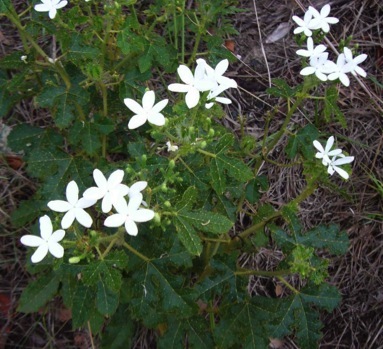
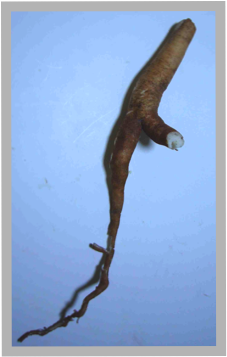
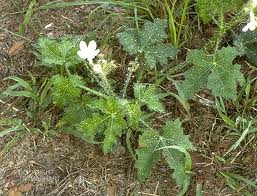
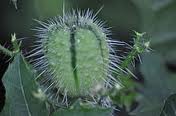
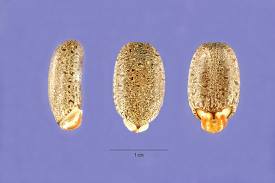

Hi Green Deane!
I think I understand the comment about not eating the upper portion of the spurge nettle root. The roots in your pictures are slender and smooth. The root I dug up recently is gigantic and seems to have a clear upper part which is about potato size but very uneven and gnarly and looks unappetizing. This attaches to the lower part of the root which was much wider and longer but smooth. The root piece is 21 inches long and 4.25 lbs. I didn’t get the whole thing because the soil became solid clay with rocks mixed in.
Hmmmm… where do you live? If it is around or west of the Mississippi that might have been the C. texanus, which has a much larger root.
That would make sense: I live in Central Texas. Unfortunately, only about a quarter to half inch outer layer around the root was edible. Most of the inner stuff was too tough. Getting it out of the ground was quite a task, and on top of that, cutting the root into cooking size pieces was even harder. None of my kitchen knives could handle the job. I had to take my coleman knife and pound it through with a hammer! When I started this endeavor, I was expecting a dainty little carrot sized snack. Instead I got this (hopefully you can see these photos on flickr) : http://www.flickr.com/photos/72446609@N05/
Unless there is a yet undiscovered way to mash/smash the inner part into digestibility, I almost certainly burned more calories than were consumed. Was it worth it? Yes! Will I ever try that again? No!
Energy out energy in. It seemed odd that such a large root was missed in ethnobotanical notes of local Indians. Research in the 50s said it didn’t have any appreciable alkaloids, and the native did eat the roasted seeds, so they knew of the plant. So perhaps it is like kudzu, there is starch there but it’s a bear to get out. One might need hammers driven by water wheels.
I am attempting to obtain some seed to raise in a greenhouse but am having no success. Is there a source? WI
A seed source for the C. stimulosus… not that I know of …. we are past season but I will see if I can see any.
Thanks! When would be the “season” ?
C. stimulosus puts on seeds in the fall, which means I might be able to find a few with seeds still if I can find the aging plant.
I’d be happy to pay for them and Merry Christmas!
I have been eating the “kernels” as my great grandmother(GGM) used to call the seeds for years with no ill effects. They taste remarkably akin to
macadamias and are extremely difficult to get to them before the wildlife. The seed pod will start to shed it’s spiny cover when it is ready. As the white shell dries out they explode, throwing the seeds as far as ten feet. It resembles the castor bean mottling with a waxy white nib, which has an aroma not unlike Limburger on the pointed end(my GGM told me that this nib was poisonous). The seeds have a paper thin shell(much like a brazil nut has under the main outer husk) which must be peeled off carefully to reveal the snow-white meat. The ONLY way that I can
consistently be assured of getting some of these jewels, is to place nylon
mesh bags around each pod and trying to harvest before they pop.
Good Hunting!
BTW: the drought was severe in my area of N Texas and I only managed to get THREE seeds.
The season begins when the warm weather sets in around late June most years. Rainfall and heat are the prevailing factors affecting yield. Seed pods will set even if there are NO seeds.
I have been trying to find a source for bull nettle root after reading about it in an old herbal from the early 1900s,with no luck at all. I usually collect my own herbs,but it doesn’t grow up here in northern Illinois. After reading your article and the readers’ comments,I can certainly understand why no one offers it! I doubt anyone could pay me enough to go through all that! I also now understand why all of the references said to make a tea instead of trying to eat it.
Didding it up is rather easy, usually just one foot down. As for drinking leaf tea… I would be careful. Those leaves may have some cyanide in them.
The references I’ve found refer to a tea made from the root,which is kind of unusual. Some tree and vine barks are used as medicinal teas,but this and echinacea are the only ‘soft root’ teas I’ve run across so far. I wouldn’t trust the leaves,just because of the urticating hairs. Even if they lose their sting from brewing,they may not soften up much. Had a bad experience with dried blackberry leaf tea for that reason,it was kinda like I’d tried to eat a baby cactus. Well,I have a friend in Arizona,maybe I can convince him to dig some for me- thanks for all the info!
As a kid, Mom would send us out to harvest “bull nettle kernels” which is what they were known as here in East Texas. We would carefully gather them, them Mom would open them for us. She always took off the white tip of the kernel… it was said to be poisonous…. and then we ate the rest. They were delicious.
I always pick drying seed heads(C. texanus) around late May early June in east Texas. No need to roast the seeds. They have a bumper crop in July. A tea of this root will make U puke. Older guys around said the root helps with ed.Root can go 6 feet in ground. Not eager to try root.
I know there are no serious alkaloids in the root, and they grow quite large, but the native did not eat them. Had to be a reason… maybe hurling was one of them.
Deane, what kind of cookware do you recommend to make sure that alkaloids, etc. don’t interact with raw harvested wild foods?
Actually I try to avoid alkaloids. I usually use cast iron or stainless steel. But I also have a lot of glassware. (I have the credentials to cook on ships so I am a closet collector of kitchen tools. )
Fellow Weed-Go’ers,
Hey, just like to let you know, the leaves of most nettles can have their stingers nullified by wilting them over a fire (camp fire) for 5 seconds on each side, and become very delicious.
m.krycer.
You have two different plant families mixed up. You are referring to Urticas. They do wilt and can be eaten, which I mention in my article on Urticas. This plant is a Cnidoscolus. You eat the cooked root. The leaves have some cyanide in them. We don’t eat them.
I think what you are describing is the very deadly castor bean.
Spurge nettle grows well in my backyard in Sumter County and the pasture behind my house, however it never seems to get very large and I have never seen it with seeds, only the white flowers. After one sting I now dig up the small plants with a shovel and put them in the trash. The root that comes up appears to be a small tap type root. Could I be digging the nettle before it makes that master huge root. The seeds do sound interesting enough to put some type of protection container around a couple of them to see how large the plant grows. That protection is for me not that little stinging devil. Love the information you share, thanks.
Been eating the Seeds for years. What I do is remove the seed pods using a hand pruner while wearing leather gloves and put the seeds in a brown paper bag where they dry and eventually they will pop fairly violently. My family normally waits about a week after the popping quit and then eats the seeds raw. Never thought about trying to eat the root, but will definitely try it next season
Thanks for writing. Which species? Where are you located?
Dear Sir/Mdm,
Would it be possible to suggest a source of seeds for this interesting plant. Thanks.
Has anyone heard of making a tincture with the root? The creek Indians here in Alabama call it “pecker root” and say it is a natural substitute for Viagra, but the only references I could find are related to stinging nettle which is a completely different species. Stinging nettle is supposed to increase free testosterone but I can find no reference at all to spurge or bull nettle as any sort of natural medicine. I did dig 8 plants about a week ago and washed and Sliced roots and then put them in mason jars and covered with 100 proof vodka to make a tincture. Going to strain and try it. Prob leave it for 8 weeks and plan to shake jars about 4 times a week.
The term Spurge is often used for any plant that contains a milky sap, so I’m not sure if you might be reading too much into the Greek/Latin translation. Great article though, and I always like to know where names come from.
As I am Greek and like to pick on dead Latin…
Hello! I’m curious about the leaves. If boiling the root gets rid of any cyanide that may be present, wouldn’t the same happen with the leaves? I have boiled and eaten the leaves before with no negative side effects, and they’re delicious! They tasted just like really good collard greens.
Quite a few folks have had the same experience.
Chaya, tree spinach, cnidnoscoleus aconitifolius, is a relative of this plant, the leaves are a delicious and easily grown nutrient rich food. And interestingly I read that in Yucatan where it is propagated traditionally, stinging varieties are favored by some over non-stinging varieties for taste, though I have only tried nonstinging Chaya. I wonder how closely these two are related.
For the past few years I have increased my foraging knowledge and experience. I love your web site and rely on it a lot.
I have a 10 acre property in NW Lamar County, Texas which is a virtual “garden of weeds.” I hope to move there soon and forage my food. Problem is, the property is “off the grid” and I have limited electricity, (Low Amp. PV panels mostly for lighting), and no access to the net. Therefore I cannot access your plant data on-line.
You have such a great web site. I access it frequently and find it very informative and useful but no provision to print the pages.
Is there a way to Hard Copy print your data pages to include in my personal library, for non-commercial use only? Or do you offer a book.
I already have the video’s which I purchased a couple of years ago but, with a limited amount of electricity to use a video disc player they are of little use.
Please advise. Thank you, Brian.
Gina from Willis, Tx just north of Houston. I cut bull nettle —Cnidoscolus texanus dry the leaves and then make a tea. I mix 1 table spoon of nettle leaves with some organic apple cinnamon tea. It seems to help with my sinuses. Ive used it off and on for months.
Never knew there was an edible root under what I had been calling “The wait 5 minutes plant “. Moved to Keystone Heights 6 years ago and I had not known the name either.
Also the article on Firebush, h something patens the link isn’t working.
Thanks for writing. The link to the article itself. I don’t think there is a link inside the article.
I’ve eaten the leaves without any noticeable ill effects both raw and boiled, I have also eaten the flowers raw; I assumed they were safe as I thought they were simply nettles but this is the first I’ve heard of them potentially containing cyanide. Yet I have eaten them in levels where I heavily doubt that there is cyanide or if there is its negligible.
Did you die? lol he was going to eat the root three different ways and we haven’t heard from him for 10 years.